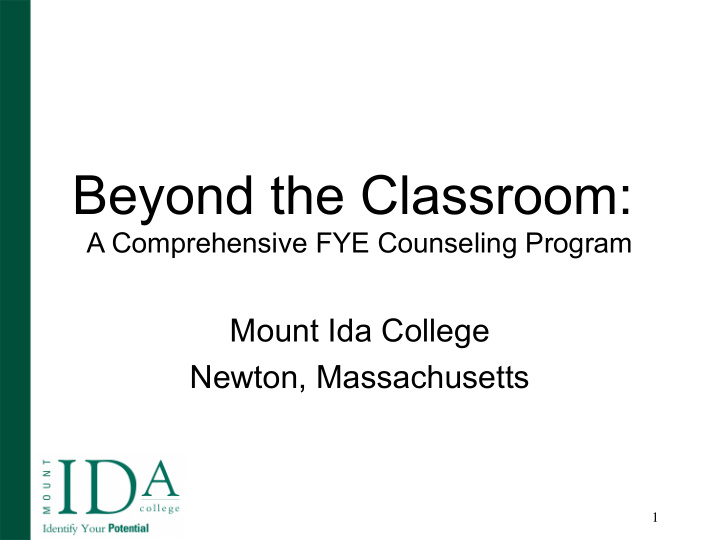



Beyond the Classroom: A Comprehensive FYE Counseling Program Mount Ida College Newton, Massachusetts 1
Mount Ida College • Baccalaureate college • 1400 students • 8 miles from downtown Boston • Professional preparation with liberal arts base • Student:faculty ratio of 14:1 • Very low discount rate
Mount Ida College • 25 majors in animal science, business, arts and sciences, design, and funeral service education • From Potential to Achievement • 538 new students in fall 2005 • 51% from Massachusetts • 25% of students are varsity athletes
Premise • Small college – very hands on approach • Enrollment management and marketing responsible for recruitment and retention • Focus on “walking across the stage” • Not about getting in – it is about getting out
Enrollment Issues • Academic readiness • Financial readiness • Financial ability (individual and institution) • Career direction and focus • Millennial Parents and Children • Transition from high school to college
FYE Counseling Model • Enrollment Management and Marketing – Admissions – Financial Aid • Student Affairs – Residence Life • Academic Affairs – Academic Services – Athletic Department • Finance and Administration – Bursar
FYE Counseling Model Assessment • Retention Audit – Established need and model premise • CIRP Survey • Noel Levitz Student Satisfaction Inventory • Noel Levitz Institutional Priorities Survey • Parent Survey (admitted/enrolled) • Financial Aid Leveraging Study
Admissions, Enrolling and Financial Planning
36 Month Plan • Process Oriented Information • Affordability • Student and Alumni Success Stories • “Walking Across the Stage”
Messaging • Tailor messages to various audiences • Repeat messaging utilizing dynamic method of delivery: – Publication Collatoral – Technology (i.e. e-mails, MySpace, website) – Counseling
What Works! • Success Academy (EMM) • First-year Experience Counseling (EMM) • STAR Days (summer orientation) (campus) • Freshman Book Experience (campus) • MySpace (EMM) • CC101/Freshman seminar (AA) • Wadsworth Lecture Series (SA/EMM)
Counseling • FYE Counseling begins at time of application • FYE Counseling ends with enrollment in sophomore class
Series of Counselors and Advisors • Admissions counselor – Goals are to accept, enroll and have student be financially clearable • Financial aid counselor – Makes award, works with admissions counselor and does intrusive financial counseling for enrolled first years –goal enroll student in sophomore class
Series of Counselors and Advisors • Peer advising from upper class students – Orientation Leaders – Resident Assistants – The Learning Circle – Balfour Peer Leaders • Academic advisors are assigned during first semester • Financial aid counselors are assigned for period of enrollment (4 years)
It Impacts Retention… • Athletics • Mount Ida College Newsletter and Inside Mount Ida • The Learning Circle/TRIO • Community Interactions
It’s Not About Whether the Students Get In • Admissions and financial counseling focuses on “right fit” and potential for achievement • Admissions Counselors are first point of contact and remain with student throughout enrollment process • Collaborative “case management” • Maintain contact for four years
After the first six weeks of enrollment pass off to Academic Affairs The Early Alert Program
Early Alert Is Designed To… • Identify first-year students early in the semester who are having difficulty in the classroom • Coordinate a supportive community response to address the student’s challenges • Increase retention and promote academic success for all students
How Early Alert Works • Faculty member meets with student to discuss challenges • Faculty member completes and submits form on College website • Form is automatically sent to several pre- determined key staff • Any contact made with the student is reported back to the Early Alert Coordinator • Follow-up by Coordinator when necessary
The Early Alert Form • On line and interactive
Who Uses The Form? • First Year Seminar Faculty • Adjunct Faculty • Faculty Teaching Developmental Courses
Early Alert Can be Initiated by any community member • Enrollment Management Committee meeting • E-mail to VPEMM
Who Receives the Form? • Representatives from: – Academic Services (Program Directors) – Financial Aid Office – Residence Life – Counseling Center – Athletic Department
Statistics • 6% of first-year student names were been submitted to the program between 9/12/06 and 10/15/06 • 80% of the issues were resolved (successfully made contact)
Conclusions • Program is most successful when the form is submitted within the first five weeks of the semester • Quick action and feedback are key to faculty involvement • Explanation of the Early Alert Program should be included in the syllabi of the professors who use the program • Explained at parent orientation
Results thus far . . . • Retention increased 5 points – 63% to 68% – Goals was to reach 68% retention by fall 2007 • Comprehensive Program assessment in 2006-2007 using Stufflebeam Program Assessment model.
Mount Ida College • www.mountida.edu
Recommend
More recommend